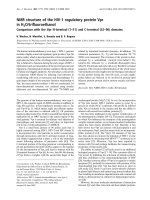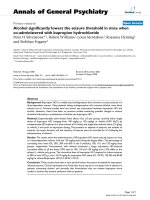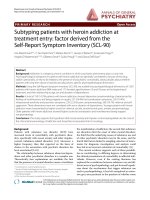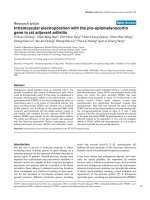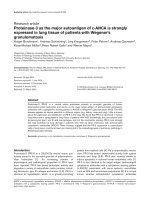Báo cáo y học: "Condensin goes with the family but not with the flow" ppsx
Bạn đang xem bản rút gọn của tài liệu. Xem và tải ngay bản đầy đủ của tài liệu tại đây (128.92 KB, 3 trang )
Genome
BBiioollooggyy
2008,
99::
236
Minireview
CCoonnddeennssiinn ggooeess wwiitthh tthhee ffaammiillyy bbuutt nnoott wwiitthh tthhee ffllooww
Marc R Gartenberg* and Matthias Merkenschlager
†
Addresses: *Department of Pharmacology, Robert Wood Johnson Medical School, University of Medicine and Dentistry of New Jersey,
Piscataway, NJ 08854, USA.
†
Lymphocyte Development Group, MRC Clinical Sciences Centre, Imperial College, London W12 0NN, UK.
Correspondence: Marc R Gartenberg. Email:
Matthias Merkenschlager. Email:
AAbbssttrraacctt
Condensin and cohesin are loaded onto yeast chromosomes by a common mechanism at RNA
polymerase III transcribed genes. Whereas cohesin translocates from these loading sites to
mediate cohesion at secondary locations, condensin remains, bringing distant sites together into
clusters.
Published: 6 October 2008
Genome
BBiioollooggyy
2008,
99::
236 (doi:10.1186/gb-2008-9-10-236)
The electronic version of this article is the complete one and can be
found online at />© 2008 BioMed Central Ltd
Structural maintenance of chromosome proteins, or SMCs for
short, are components of a variety of complexes that are
central to the organization, utilization and segregation of
chromosomes [1]. SMCs are unusually large proteins that fold
on themselves to form long coiled coils with an ATPase head
at one end. A dimerization motif at the other end allows the
proteins to form SMC pairs, which in turn associate with
additional structural and regulatory factors. The Smc1 and
Smc3 dimer forms the core of the complex known as cohesin,
which mediates sister-chromatid cohesion by directly binding
sister chromatids together until the onset of anaphase. The
Smc2 and Smc4 dimer forms the core of condensin, a protein
complex that facilitates DNA chromosome condensation in
preparation for mitotic segregation. An additional pair of
proteins, Smc5 and Smc6, forms the core of a less well
understood complex with important roles in several critical
processes including DNA damage checkpoint response and
repair. Figure 1a shows schematic representations of SMC
complexes and their subunits.
Cohesin is the best studied of the SMC protein complexes.
The head domains of the coiled-coil dimer are joined by a
third conserved subunit known as a kleisin to form a large
protein ring with the central void spanning 30-40 nm [2].
Cohesin binds DNA topologically by entrapping double-
stranded DNA molecules within the ring [3]. An accumu-
lating body of evidence supports the notion that cohesin
mediates cohesion by embracing the DNA of both sister
chromatids [4].
Much less is known about condensin [5]. The complex
appears to be rod-like rather than ring-shaped in electron
micrographs [6]. It also possesses a mitotically stimulated,
ATP-dependent supercoiling activity not found in cohesin
[7]. Despite these differences, the conserved structure of the
kleisin and SMC subunits suggests that there might be
similarities in the way condensin and cohesin associate with
DNA. A step toward addressing this possibility was made
when cohesin was mapped at high resolution across the
budding and fission yeast genomes [8,9]. Massive amounts
were found near the centromeres, where the complex
counteracts the pulling forces of microtubules from opposite
poles of the mitotic spindle. Cohesin was also found at
discrete sites on chromosome arms in the intergenic regions
between pairs of convergently transcribed genes. Now, a new
study from the laboratory of Frank Uhlmann published in
Genes and Development (D’Ambrosio et al. [10]) reports the
genome-wide addresses of yeast condensin at high
resolution. This work uncovers striking similarities - and
significant differences - in the way these two SMC complexes
assemble on chromosomes.
CCoonnddeennssiinn aanndd ccoohheessiinn sshhaarree aa ccoommmmoonn aasssseemmbbllyy
ppaatthhwwaayy
As with cohesin, D’Ambrosio et al. find condensin located at
discrete sites, with the number of sites increasing propor-
tionally with chromosome size. However, besides finding
condensin with cohesin at centromeres and the rDNA array,
where both complexes are known to act [11,12], there was
little overlap between the remaining sites on chromosomal
arms. Instead, condensin sites correlated most closely with
the mapped positions of Scc2, an essential component of the
cohesin-loading complex, which also contains Scc4. Previous
work had shown that cohesin first associates with these sites
and then rapidly redistributes to its final destinations [8]. To
determine whether Scc2/4 participates in condensin load-
ing, D’Ambrosio et al. turned to conditional mutants of
either Scc2 or Scc4. They found that inactivating either
protein not only reduced the amount of bound condensin
but also eliminated cytological benchmarks of yeast
chromosome condensation. Thus, the authors conclude that
Scc2/4 is both a cohesin- and a condensin-loading complex.
That the chromosomal association of Smc5/6 also requires
Scc2/4 suggests that all the SMC complexes associate with
DNA via the same pathway [13].
What does Scc2/4 do to achieve loading of SMC complexes?
Previous work found that the ATPase activity of cohesin is
essential for binding [14,15]. There was speculation that
Scc2/4 in conjunction with the Smc1/3 ATPases opened up
cohesin to place DNA within the protein ring. Whether
condensin and Smc5/6 also bind DNA topologically awaits
experimental validation. However, given that all three
complexes are assembled on DNA by the same evolutionarily
conserved complex, it seems like a reasonable hypothesis.
CCoonnddeennssiinn//ccoohheessiinn llooaaddiinngg ssiitteess ddeeffiinneedd bbyy RRNNAA
ppoollyymmeerraassee IIIIII ccoommppoonneennttss
The new maps of condensin and Scc2/4 binding uncovered
an additional relationship not appreciated in earlier studies
of either complex [8,16]. D’Ambrosio et al. [10] discovered
that the shared condensin- and Scc2/4-binding sites corres-
pond closely to genes transcribed by RNA polymerase III.
This set of genes included the majority of the yeast tRNA
genes, of which there are 274 distributed across the genome.
Both complexes were even found at some sites known as
ETCs, where the general transcription factor TFIIIC binds in
the absence of all other RNA polymerase III machinery [17].
While some condensin bound to sites with little or no TFIIIC
(centromeres, for example), these results point strongly
toward a condensin-loading pathway centered on TFIIIC.
D’Ambrosio et al. [10] embarked on a series of experiments
to determine whether TFIIIC causes, or just coincides with,
condensin binding. First, they showed that introduction of a
high-affinity TFIIIC recognition element, the B box, was
sufficient to recruit both TFIIIC and condensin. Next they
showed that deletion of an existing tRNA gene reduced the
surrounding Scc2/4 and condensin. Finally, they demon-
strated that inactivation of one of the TFIIIC subunits
reduced the amount of Scc2/4 and condensin bound to
chromosomes. Taken together, these data strongly support a
model in which TFIIIC recruits Scc2/4, which in turn loads
condensin onto chromosomes.
SSMMCC ffaammiillyy cchhooiicceess:: ttoo ttaakkee rroooott oorr lleeaavvee tthhee nneesstt
Unlike cohesin, condensin remains at the Scc2/4 sites
throughout the cell cycle, suggesting that the two SMC
complexes differ in their mobility after loading. Topological
linkage, it was reasoned, endows cohesin with the ability to
sample many sites without ever leaving DNA. Thus, sites of
loading need not coincide with sites of action. This is
probably the case for the silenced HMR mating-type locus,
where the requirement for a neighboring tRNA gene in
cohesion can now be explained in terms of Scc2/4-mediated
/>Genome
BBiioollooggyy
2008, Volume 9, Issue 10, Article 236 Gartenberg and Merkenschlager 236.2
Genome
BBiioollooggyy
2008,
99::
236
FFiigguurree 11
Structure, loading and repositioning of SMC complexes in budding yeast.
((aa))
Schematic representation of cohesin, condensin and Smc5/6. Subunits
are identified using the
Saccharomyces cerevisiae
nomenclature. The ring-
and rod-like shapes of cohesin and condensin are based on electron
micrographs.
((bb))
Cohesin and condensin are both loaded by Scc2/4
(purple) at sites bound by the entire RNA polymerase III transcriptional
apparatus (blue) or at sites bound by TFIIIC alone. Subsequently, cohesin
moves to distant locations, embracing DNA and holding the newly
replicated sister chromatids together from S phase until mitosis.
Condensin stays in contact with the loading sites, bringing together
distant TFIIIC sites.
Ring shaped Rod shaped
Smc2
Smc4
Smc5/6
Smc5
Smc6
Smc1
Smc3
Nse1
Qri2
YDR228W
Mms21
Scc3
Mcd1/Scc1
Brn1
Ycs4
Ycg1
CondensinCohesin
Cohesion Condensation
Scc2/4
RNA polymerase III
machinery
(a)
(b)
loading of cohesin at the gene followed by translocation of
the complex to HMR [18]. Similarly, when cohesin accumu-
lation was monitored at representative convergent gene
pairs, the complex was found first at Scc2/4 sites, sometimes
situated more than 10 kb away [8]. It appears, therefore, that
cohesin translocation allows the loading and accumulation
sites to be separated by substantial distances (Figure 1b).
Why does condensin not translocate after Scc2/4 loading? A
simple explanation might be that the complex does not
assemble with DNA trapped inside a topological embrace.
Alternatively, the complex binds topologically but remains
fixed to serve a dedicated function at loading sites. A more
fanciful explanation for the apparent persistence of conden-
sin at loading sites is that the complex is actually quite
mobile, but translocates while maintaining contact with the
original loading site. If the migrating complex were only to
stop when encountering another loading site (or fall off in
between) then it would appear as if condensin complexes
were only at loading sites. In this way, condensin could bring
together distant sites into clusters. Indeed, TFIIIC-bound
elements in fission yeast form clusters at the nucleolus and
nuclear periphery [19].
Budding yeast tRNA genes cluster at the nucleolus, too [20].
In the same issue of Genes and Development, a team led by
David Engelke reported that clustering of the budding yeast
tRNA genes, and the attendant silencing of adjacent RNA
polymerase II reporter constructs, requires functional con-
densin genes (Haeusler et al. [21]). These findings suggest
that condensin, either through the ability to oligomerize or
the ability of single complexes to bind multiple sites, brings
together the dispersed tRNA genes (Figure 1b). Accordingly,
condensin might be retained at TFIIIC sites to serve as a
structural element in the three-dimensional folding of
chromosomes. This level of organization persists throughout
the cell cycle, and conceivably may precede additional levels
of packaging at mitosis.
The results of D’Ambrosio et al. [10] raise intriguing
questions as to how and why condensin stays in touch with
its loading sites, while cohesin moves away. The explanation
is likely to relate to the specialized functions of the different
SMC complexes, and the need to distinguish between intra-
chromatid and inter-chromatid contacts when implementing
cohesion and condensation for the accurate segregation of
chromosomes at mitosis.
AAcckknnoowwlleeddggeemmeennttss
This work was supported by funding to MRG from the NIH (GM51402)
and the March of Dimes (1-FY08-481) and to MM from the Medical
Research Council, UK.
RReeffeerreenncceess
1. Nasmyth K, Haering CH:
TThhee ssttrruuccttuurree aanndd ffuunnccttiioonn ooff SSMMCC aanndd
kklleeiissiinn ccoommpplleexxeess
Annu Rev Biochem
2005,
7744::
595-648.
2. Gruber S, Haering CH, Nasmyth K:
CChhrroommoossoommaall ccoohheessiinn ffoorrmmss aa
rriinngg
Cell
2003,
111122::
765-777.
3. Ivanov D, Nasmyth K:
AA ttooppoollooggiiccaall iinntteerraaccttiioonn bbeettwweeeenn ccoohheessiinn
rriinnggss aanndd aa cciirrccuullaarr mmiinniicchhrroommoossoommee
Cell
2005,
112222::
849-860.
4. Haering CH, Farcas AM, Arumugam P, Metson J, Nasmyth K:
TThhee
ccoohheessiinn rriinngg ccoonnccaatteennaatteess ssiisstteerr DDNNAA mmoolleeccuulleess
Nature
2008,
445544::
297-301.
5. Hirano T:
AAtt tthhee hheeaarrtt ooff tthhee cchhrroommoossoommee:: SSMMCC pprrootteeiinnss iinn aaccttiioonn
Nat Rev Mol Cell Biol
2006,
77::
311-322.
6. Anderson DE, Losada A, Erickson HP, Hirano T:
CCoonnddeennssiinn aanndd
ccoohheessiinn ddiissppllaayy ddiiffffeerreenntt aarrmm ccoonnffoorrmmaattiioonnss wwiitthh cchhaarraacctteerriissttiicc hhiinnggee
aanngglleess
J Cell Biol
2002,
115566::
419-424.
7. Kimura K, Hirano T:
AATTPP ddeeppeennddeenntt ppoossiittiivvee ssuuppeerrccooiilliinngg ooff DDNNAA
bbyy 1133SS ccoonnddeennssiinn:: aa bbiioocchheemmiiccaall iimmpplliiccaattiioonn ffoorr cchhrroommoossoommee ccoonn
ddeennssaattiioonn
Cell
1997,
9900::
625-634.
8. Lengronne A, Katou Y, Mori S, Yokobayashi S, Kelly GP, Itoh T,
Watanabe Y, Shirahige K, Uhlmann F:
CCoohheessiinn rreellooccaattiioonn ffrroomm ssiitteess
ooff cchhrroommoossoommaall llooaaddiinngg ttoo ppllaacceess ooff ccoonnvveerrggeenntt ttrraannssccrriippttiioonn
Nature
2004,
443300::
573-578.
9. Glynn EF, Megee PC, Yu HG, Mistrot C, Unal E, Koshland DE,
DeRisi JL, Gerton JL:
GGeennoommee wwiiddee mmaappppiinngg ooff tthhee ccoohheessiinn ccoommpplleexx
iinn tthhee yyeeaasstt
SSaacccchhaarroommyycceess cceerreevviissiiaaee
PLoS Biol
2004,
22::
E259.
10. D’Ambrosio C, Schmidt CK, Katou Y, Kelly G, Itoh T, Shirahige K,
Uhlmann F:
IIddeennttiiffiiccaattiioonn ooff cciiss aaccttiinngg ssiitteess ffoorr ccoonnddeennssiinn llooaaddiinngg
oonnttoo bbuuddddiinngg yyeeaasstt cchhrroommoossoommeess
Genes Dev
2008,
2222::
2215-2227.
11. Yong-Gonzalez V, Wang BD, Butylin P, Ouspenski I, Strunnikov A:
CCoonnddeennssiinn ffuunnccttiioonn aatt cceennttrroommeerree cchhrroommaattiinn ffaacciilliittaatteess pprrooppeerr kkiinnee
ttoocchhoorree tteennssiioonn aanndd eennssuurreess ccoorrrreecctt mmiittoottiicc sseeggrreeggaattiioonn ooff ssiisstteerr
cchhrroommaattiiddss
Genes Cells
2007,
1122::
1075-1090.
12. Lavoie BD:
ppRRbb aanndd ccoonnddeennssiinn——llooccaall ccoonnttrrooll ooff gglloobbaall cchhrroommoossoommee
ssttrruuccttuurree
Genes Dev
2008,
2222::
964-969.
13. Lindroos HB, Ström L, Itoh T, Katou Y, Shirahige K, Sjögren C:
CChhrroommoossoommaall aassssoocciiaattiioonn ooff tthhee SSmmcc55//66 ccoommpplleexx rreevveeaallss tthhaatt iitt
ffuunnccttiioonnss iinn ddiiffffeerreennttllyy rreegguullaatteedd ppaatthhwwaayyss
Mol Cell
2006,
2222::
755-
767.
14. Arumugam P, Gruber S, Tanaka K, Haering CH, Mechtler K,
Nasmyth K:
AATTPP hhyyddrroollyyssiiss iiss rreeqquuiirreedd ffoorr ccoohheessiinn’’ss aassssoocciiaattiioonn wwiitthh
cchhrroommoossoommeess
Curr Biol
2003,
1133::
1941-1953.
15. Weitzer S, Lehane C, Uhlmann F:
AA mmooddeell ffoorr AATTPP hhyyddrroollyyssiiss
ddeeppeennddeenntt bbiinnddiinngg ooff ccoohheessiinn ttoo DDNNAA
Curr Biol
2003,
1133::
1930-
1940.
16. Wang BD, Eyre D, Basrai M, Lichten M, Strunnikov A:
CCoonnddeennssiinn
bbiinnddiinngg aatt ddiissttiinncctt aanndd ssppeecciiffiicc cchhrroommoossoommaall ssiitteess iinn tthhee
SSaacccchhaa
rroommyycceess cceerreevviissiiaaee
ggeennoommee
Mol Cell Biol
2005,
2255::
7216-7225.
17. Moqtaderi Z, Struhl K:
GGeennoommee wwiiddee ooccccuuppaannccyy pprrooffiillee ooff tthhee RRNNAA
ppoollyymmeerraassee IIIIII mmaacchhiinneerryy iinn SSaacccchhaarroommyycceess cceerreevviissiiaaee rreevveeaallss llooccii
wwiitthh iinnccoommpplleettee ttrraannssccrriippttiioonn ccoommpplleexxeess
Mol Cell Biol
2004,
2244::
4118-4127.
18. Dubey RN, Gartenberg MR:
AA ttDDNNAA eessttaabblliisshheess ccoohheessiioonn ooff aa
nneeiigghhbboorriinngg ssiilleenntt cchhrroommaattiinn ddoommaaiinn
Genes Dev
2007,
2211::
2150-
2160.
19. Noma K, Cam HP, Maraia RJ, Grewal SI:
AA rroollee ffoorr TTFFIIIIIICC ttrraannssccrriipp
ttiioonn ffaaccttoorr ccoommpplleexx iinn ggeennoommee oorrggaanniizzaattiioonn
Cell
2006,
112255::
859-872.
20. Haeusler RA, Engelke DR:
SSppaattiiaall oorrggaanniizzaattiioonn ooff ttrraannssccrriippttiioonn bbyy
RRNNAA ppoollyymmeerraassee IIIIII
Nucleic Acids Res
2006,
3344::
4826-4836.
21. Haeusler RA, Pratt-Hyatt M, Good PD, Gipson TA, Engelke DR:
CClluusstteerriinngg ooff yyeeaasstt ttRRNNAA ggeenneess iiss mmeeddiiaatteedd bbyy ssppeecciiffiicc aassssoocciiaattiioonn ooff
ccoonnddeennssiinn wwiitthh ttRRNNAA ggeen
nee ttrraannssccrriippttiioonn ccoommpplleexxeess
Genes Dev
2008,
2222::
2204-2214.
/>Genome
BBiioollooggyy
2008, Volume 9, Issue 10, Article 236 Gartenberg and Merkenschlager 236.3
Genome
BBiioollooggyy
2008,
99::
236





